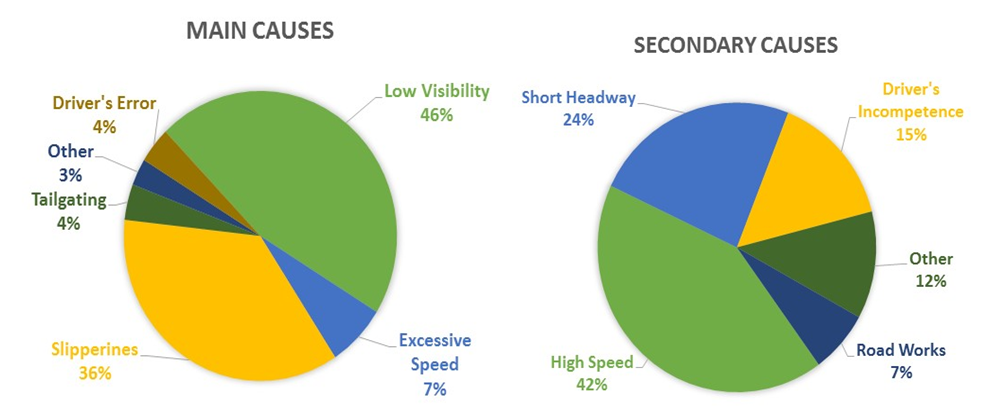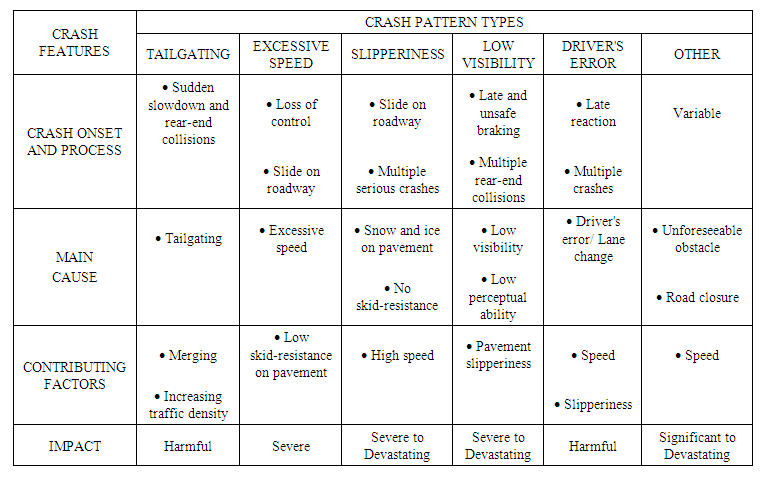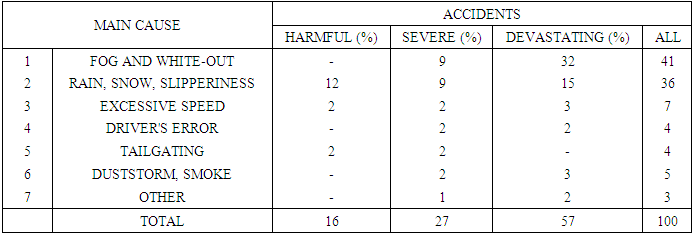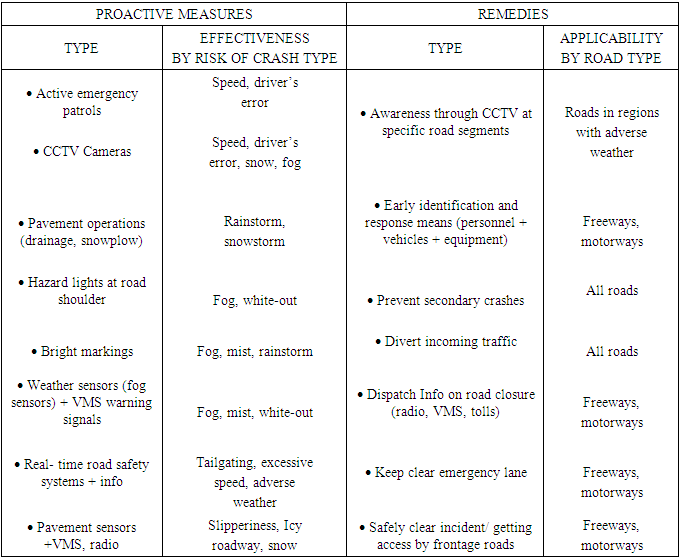-
Paper Information
- Paper Submission
-
Journal Information
- About This Journal
- Editorial Board
- Current Issue
- Archive
- Author Guidelines
- Contact Us
International Journal of Traffic and Transportation Engineering
p-ISSN: 2325-0062 e-ISSN: 2325-0070
2023; 12(2): 15-21
doi:10.5923/j.ijtte.20231202.01
Received: Apr. 28, 2023; Accepted: May 12, 2023; Published: May 23, 2023

Multifaceted Analysis of Multiple Vehicle Collisions on Motorways
Anastasios Mouratidis
Professor Em., Aristotle Univ. of Thessaloniki, Dr. Ing. Univ. Paris VI
Correspondence to: Anastasios Mouratidis, Professor Em., Aristotle Univ. of Thessaloniki, Dr. Ing. Univ. Paris VI.
| Email: |  |
Copyright © 2023 The Author(s). Published by Scientific & Academic Publishing.
This work is licensed under the Creative Commons Attribution International License (CC BY).
http://creativecommons.org/licenses/by/4.0/

Multiple-Vehicle Collisions (MVC) are chain-reaction road accidents involving three or more vehicles. They are a rare type of severe traffic incidents and, usually, occur on major roads, such as, motorways and national arteries, under high traffic volume. Successive vehicle crashes, on these major transport links, produce not only road closures, but also, very often, injuries and fatalities. Due to their nature, severity and extent, multiple-vehicle collisions are one of the most disastrous and fatal types of road accidents. The hereby research focuses on the features of severe multiple-vehicle collisions and attempts to identify the most recurring causes of these accidents. Low visibility, pavement slipperiness and inconsiderate driving are recognized as common major causes, while tailgating, high speed and road works are also pointed out as factors susceptible to generate multiple crashes. Based on data available from journal reports, a concise interpretation of the causes of these MVC’s was conducted and is hereby presented. Moreover, a statistical analysis on the distribution of multiple vehicle collisions by crash cause and impact has also been carried out, meant to explore and to identify the most adverse conditions for traffic safety. The research concludes with a list of proposed proactive measures, adequate to motorways, which may prove to be beneficial in the case of uncertain safety conditions, as well as, with remedies to be applied after an incident, to alleviate a stressful situation and to mitigate the risk for secondary crashes.
Keywords: Road, Motorway, Safety, Accident, Vehicle
Cite this paper: Anastasios Mouratidis, Multifaceted Analysis of Multiple Vehicle Collisions on Motorways, International Journal of Traffic and Transportation Engineering, Vol. 12 No. 2, 2023, pp. 15-21. doi: 10.5923/j.ijtte.20231202.01.
Article Outline
1. Background
- Multiple-Vehicle Collisions (MVC) are chain-reaction road accidents involving three or more vehicles. They usually occur on major roads, such as motorways, interstates, international links, ring roads and national arteries of high traffic volume. Due to their nature, severity and extent, multiple-vehicle collisions are one of the most disastrous and fatal types of road accidents.In fact, multiple-vehicle collisions may be classified into many different categories. However, there are two main categories of this type of accidents. The first category regards congested ring roads, urban and peri-urban freeways and comprises accidents occurring under high traffic volume and decelerating conditions. Sudden change in speed of one vehicle may generate a sequence of rear-end collisions, due to high density of vehicles and insufficient headway.The second category of multiple vehicle collisions refers to accidents occurring mainly due to low visibility or unexpected driving conditions on inter-urban motorways. The setting, in this case, is quite different and the consequences are usually much more severe. In this type of accidents, low visibility, pavement slipperiness and driver skills play a major role.Research on multiple-vehicle collisions has been conducted, principally, in terms of relative velocity of vehicles [Sugihama and Nagatani, 2013] and of the effect of the first crash to the subsequent collisions [Nagatani, 1993]. The mathematical model used adopts reasonable assumptions with regard to the tire-pavement friction on the roadway and the collision process.Exploring the difference in causality factors between single- and multiple-vehicle crashes, research has been carried out on two-lane roads with interesting findings on the effect of junctions, signals, Level Of Service (LOS), shoulder width and age of drivers [Ivan et al. 1999, Martensen and Dupont, 2013].Accounting for the complexity of the physical simulation of a multiple-vehicle crash, researchers have applied the Monte-Carlo method to reconstruct a specific traffic accident [Daily J. and Daily J., 2004]. The Monte Carlo method was used to propagate the uncertainty of the evidence through to the initial speeds of the involved vehicles.In terms of an approach closer to road engineering, State Highway Authorities and Institutes have elaborated practical recommendations, in the form of Tables, regarding the headway to observe under uncertain, crash-prone conditions [AASHTO, 2018/ Austroads, 2016]. However, what is even more important and beneficial to drivers is a set of proactive measures by the Road Operating Authorities, with view to preventing accidents or to mitigating their impact. The hereby research on the features of a significant number of serious multiple-vehicle collisions is based on brief reports and rough estimates on these road incidents. It aims to identify the most recurring causes of these accidents and to connect accident causes with crash patterns and risks. The research concludes with several measures, adequate to specific weather and traffic conditions in each region and highway, which may significantly improve the level of road safety.
2. Safety on Motorways
- Construction of motorways started in Germany and in Italy before the 2nd World War. Several years later, the Pennsylvania Turnpike was built in the USA. After the war, construction of motorways expanded in all industrialized countries and, more recently, in most developing countries [Mouratidis A., Kehagia F, 2014].The objective was to increase traffic safety, to improve serviceability and to reduce travel time for the benefit of drivers and passengers. In fact, nowadays, motorways are, by far, the safest road links, much safer than regional and national roads [Kehagia F., 2013].However, road accidents still occur on motorways, despite the net improvement of the traffic safety level in the EU [ERSO, 2017]. Head-on collisions are extremely rare, practically inexistent, but rear-end and run-off crashes are relatively usual. Driver’s distraction, high speed, defective vehicle are common causes of these accidents. During 2019, 23.000 fatalities were recorded in accidents occurred on the EU road networks [ERF, EU Road Statistics, 2020]. On national and regional roads, as well as on motorways, it seems that there is still a lot to be done in the field of traffic safety.
3. Multiple Vehicle Collisions: Occurrence and Causes
- Among different types of road safety incidents, a rather infrequent, but really dreadful type of accident on motorways, is the multiple-vehicle collision (MVC), equally known as “pile-up accident”. It is often a disastrous crash involving many vehicles, generating fatalities, multiple injuries, road distress and closure. The common sequence of events in a multiple-vehicle collision is as follows: a driver suddenly becomes aware of an immobile obstacle or a decelerating vehicle in front, he/she is driven to brake abruptly, fails and hits the rear-end of the obstacle/car in front and a sequence of collisions starts; many vehicles crash on to one another, thus, creating a desperate situation on the motorway.In the case of congested motorways, mostly urban and peri-urban, insufficient headway, combined with late driver reaction may lead to multiple rear-end collision. Accidents of this type usually occur at low speed and rarely produce severe injuries or fatalities [Shefer D. and Rietveld P., 1997].In the case of interurban motorways, thick fog seems to create serious incidents [Chen and Hsiung, 2018, Li et al. 2021] and seems to be the most common triggering cause of multiple crashes. It should be mentioned that, in many reported cases, thick fog seems to have appeared suddenly before the driver. The situation is quite different if the driver is aware of the potential hazard and the risk is mitigated by utmost vigilance.The occurrence of multiple-vehicle collisions under low visibility conditions in the USA was extensively investigated through a comprehensive research by the AAA Foundation for Traffic Safety, 2014. The research pointed out that fatal crashes due to fog, as percentage of all type crashes on interurban roads, vary from 1-2%, while on motorways with median, this percentage drops to 1%.
4. Research over Serious Multiple Crashes
- In the Aristotle University, research was conducted on 106 serious multiple crashes, occurred on peri-urban and interurban motorways (1989-2023), in different countries. Common characteristics of these MVC’s were the severity of the impact of the accidents and the availability of reported data. Data were collected from brief reports of daily journals which contain rough estimates on traffic figures and on the road context. In specific cases, additional input from other sources, such as, road alignment, topography and climate features, had to be taken into consideration. The research focused on the road characteristics, the crash figures and the reported or assumed causes of each accident. It was found that the most common causes of the MVC type of accidents may be classified into 5 categories, related to: a. weather conditions-low visibility: thick fog, rainstorm, snowstorm, tornado, smokeb. driver: excessive speed, distraction, dizziness, inconsiderate driving, clumsy driving, insufficient headwayc. road and traffic: lane closure due to maintenance works, unreasonable full roadway closure, sudden lane or roadway closure, high traffic volume d. pavement slipperiness: snow, ice, water film, oil, black icee. unexpected event or obstacle: stopped vehicle, crossing animal, vehicle breakdown, rockfall.In search for the origin of each MVC, it seems difficult to identify the main cause and, eventually, the secondary cause of each accident, especially if low visibility, slipperiness and high speed share parts and roles in the same dreadful event. However, an attempt for a reasonable classification of the accident causes has been made. With regard to other parameters related to these accidents, a comprehensive assessment indicates that straightness of the alignment, inviting for high speed, plays a rather negative role to traffic safety, while high traffic volume is a precondition to an MVC. The main findings, including an overview of road features and of primary and secondary causes of the MVC’s examined, are summarized in Table 1.
|
 | Figure 1. Main and secondary causes of Multiple Vehicle Collisions |
5. Collision Patterns and Impact
- A generalized simulation of a multiple-vehicle-collision seems an extremely difficult task. It would require too many random variables and unknown parameters, including initial speed for every vehicle, angle of each collision, post-collision angles of motion, post-impact velocities, tire-pavement friction coefficient and the rate of inelasticity of each collision. However, for specific cases, attempts of mathematical formulation of the collision process have been made [Daily J and Daily J., 2004]. In the frame of the present research, multiple-vehicle collisions are classified into 6 main categories, each one characterized by the collision pattern, the main cause and the contributing factors (Table 2). Although, each multiple vehicle accident is unique, this classification seems to be a pre-requisite to the identification of the most adequate pro-active measures for each highway. Slippery roads need different measures from fog-prone highways. However, there are measures, mainly regarding information to drivers, beneficial in every highway, since they help prevent secondary crashes and significant delays.
 | Table 2. Classification of MVC types |
|
6. Kinetic and Potential Energy
- In terms of physics, both the kinetic energy and the total momentum of all involved vehicles are set to zero after impact, since all velocities drop finally down to zero as well. Throughout the impact process, the total kinetic energy K is dissipated, mainly by conversion to potential energy of deformation of vehicles and structures P, but also to thermal energy T:K (kinetic energy) = P (potential energy of deformation) + E (fracture energy on vehicles and structures) + T (thermal energy on vehicles and structures) + W (work against tire/pavement friction) + A (other, sound, air resistance).This equation points out the importance of the speed factor in all types of multiple-vehicle collisions, since
 where m stands for mass and v for speed.The amount of the energy of deformation produced during a crash event depends greatly on the initial kinetic energy of the vehicles involved. In this regard, car manufacturers strive to produce vehicle structures susceptible to absorb kinetic energy by deformation of the bumpers and of the end frames of the vehicle body, leaving the passenger cabin intact. In terms of road engineering, although energy consumed against pavement friction is usually a small part of the total energy, it is important to maximize it, in all types of probable traffic accidents. This can be achieved by proper asphalt types of increased skid-resistance (§ 7). By contrast, thermal energy on vehicles, susceptible to provoke fire, may be disastrous and must be controlled through anti-flammable constituent materials of the vehicle structure.
where m stands for mass and v for speed.The amount of the energy of deformation produced during a crash event depends greatly on the initial kinetic energy of the vehicles involved. In this regard, car manufacturers strive to produce vehicle structures susceptible to absorb kinetic energy by deformation of the bumpers and of the end frames of the vehicle body, leaving the passenger cabin intact. In terms of road engineering, although energy consumed against pavement friction is usually a small part of the total energy, it is important to maximize it, in all types of probable traffic accidents. This can be achieved by proper asphalt types of increased skid-resistance (§ 7). By contrast, thermal energy on vehicles, susceptible to provoke fire, may be disastrous and must be controlled through anti-flammable constituent materials of the vehicle structure. 7. Measures and Remedies
- Measures are imperative to prevent probable accidents due to sudden drop in visibility, as well as, to imperceptible pavement slipperiness. In this regard, proactive measures, including new technologies, are proposed and safety priorities are presented, suitable to Motorway Operators (Table 4). In line with the findings of the present research over the causes of MVC’s, warning measures, suggesting vigilance and caution to drivers, are mostly recommended.
|
8. Conclusions
- Multiple-vehicle collisions on motorways are disastrous. They occur rarely but their consequences are severe. The present research on serious MVC’s recognized that low visibility is the main triggering factor for MVC’s. In case of thick fog or white-out conditions a slippery pavement and inconsiderate driving contribute to a severe MVC.Rainstorms, snowstorms and ice on the roadway, drastically minimizing skid-resistance, are also factors likely to produce severe multiple crashes on motorways. Likewise, high speed, in this case, amplifies the harmful impact of the accident.Proactive measures to prevent MVC’s must be specifically determined by probable crash risk, while real-time safety prediction models, implemented in high risk road segments, seem to be most effective innovative tools.Prevention of the chain-reaction effect is of great importance in all types of road accidents. Digital information, well-planned traffic incident management and adequately trained personnel will prevent secondary crashes, congestion, unpleasant/despairing situations and save lives in a high-standards motorway.
 Abstract
Abstract Reference
Reference Full-Text PDF
Full-Text PDF Full-text HTML
Full-text HTML

